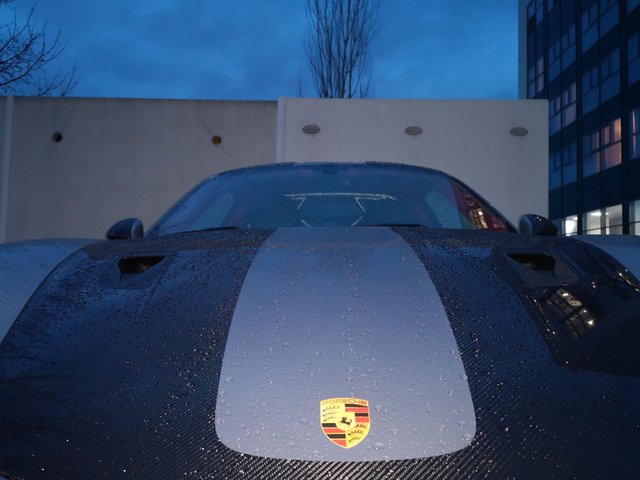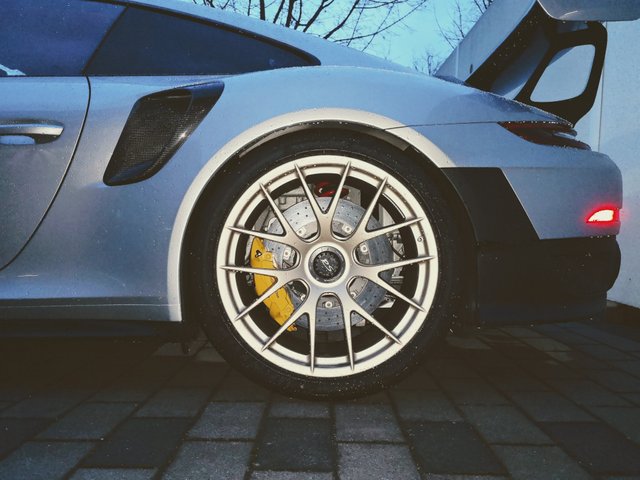Car Scooping #17 - 2019 911 GT2 RS

The following is the newest installment of my decade old practice of taking lots of special pictures of special cars when I see them out in the wild. This immaculate and seemingly brand new 911 GT2 RS (991) was parked behind a hotel near my workplace.

I've done many cars over the years anything from Bugatti to old Opels but this one was special I could feel it standing next to it.

I deliberately am going for a wild mixture of photo styles here full color, black and white, high contrast, high exposure, high/low saturation because the grey/black/silver color combination lends itself to all kinds of styles and because I felt like mixing things up a bit.
Of course I used the occasion to create a signature 'Michael Mann Hoodshot'...

...which works amazingly well on this car. I'm referring to a camera angle used by Director Michael Mann in movies such as Heat, Miami Vice and Collateral in which the camera is mounted at the front of the bumper pointing towards the windscreen. By zooming out a wideangle is created in which the hood is seemingly superimposed over the passenger compartment - great perspective work and I always loved that shot.

991 911 GT2 RS
As for the car well there is no shortage of superlatives. The engine builds on Porsche's signature flat 6 with 3.6L displacement introduced in 2009. It is equipped with two twinscroll turbochargers with variable geometry (VTG chargers).
VTG
In short the old turbo Porsches suffered from a considerable and characteristic turbo lag where the engine literally wouldn't pull at all below 3.500rpms before exploding into an ever faster and more violent pull after 3.500rpm right up onto what eventually became 7.000rpm. In recent years Porsche has pioneered the variable geometry chargers which means the turbo propeller blade angles can be altered thereby affecting the degree of intake air compression it achieves. This is useful to run the turbo optimally in different engine rpm regimes as well as under varying exhaust gas temperatures and loads.

In addition, the turbos have two scrolls (propellers) that can be independently actuated so as to further increase turbo efficiency even in low rpms thereby making turbo lag a thing of the past. Variable valve actuation and variable valve lift are other technologies to mitigate low end lack of torque as well as run the engine more efficiently whereby Porsche only uses the variable valve actuation. BMW is the only manufacturer who utilizes variable valve actuation, lift control and turbo geometry all at once.
Furthermore the engine is equipped with two such VTG chargers. I'm unfamiliar with the setup but can imagine Porsche uses both chargers equally for one bank each and not like BMW does it putting one charger in for lower revs and one for higher ones.

In any case this engine is bored out to 3.8L and is the base engine of the 991 911 GT3 RS which is naturally aspirated and has no charging at all. That engine generated 500hp in its base setup which was the highest per liter performance of a mass produced engine to date. By adding two VTG chargers the engine's output is raised to 700hp and 750nm of torque.
Amazingly the rev limiter is set at a for turbo engines incredible and world record worthy 7.200rpms.
So we have the highest reving, highest output factory turbo engine in the world sitting in the back of this car.


The body work indentations in the front and rear bumpers are taken straight from Porsche's Le Mans entry the 2017 911 RSR as are the stylish yet functional front wheel well vents. These vents help air which gets compressed in the wheel well at high speeds to exit the well thereby reducing lift and helping the car to achieve tremendous grip levels and cornering speeds as well as high speed stability.

Engine specs straight from Porsche:
Engine layout | Rear engine
Number of cylinders | 6
Bore | 102.0 mm
Stroke| 77.5 mm
Displacement | 3,800 cm³
Power (kW) | 515 kW
Power (hp) | 700 PS
RPM maximum power | 7,000 r/min
Max. torque | 750 Nm at 2,500 - 4,500 r/min
Maximum engine speed | 7,200 r/min
Max. output per liter (kW/l) | 135.5 kW/l
Max. output per liter (hp/l) | 184.2 PS/l
What makes the GT2 a GT2?

Well at Porsche there's an age old nomenclature which goes as follows. The base 911 used to have a naturally aspirated flat 6 and was available in all kinds of variations and power stages. The turbo is a turbocharged 911 which nowadays they actually all are but the turbo still holds a considerable technology and power advantage over its 'regular' brethren. The original turbo was a rear wheel drive only car. Starting with the 993 911 turbo in 1995 it got all wheel drive and henceforth all turbos were all wheel drive cars.

Next to the turbo the GT3 is the ultimate high output street racer but with a naturally aspirated engine. It got famous for its extremely high revving N/A flat 6 usually bored out to ever greater displacement culminating in the world record holding 991 GT3 with its 4.0L 500hp naturally aspirated flat 6 engine.
So what is the GT2? Simple, it is a 911 turbo with rear wheel drive and usually a bump in power. So i hear you think 'take out a stability piece such as all wheel drive, further reducing the dry weight and then adding even more power? You bet.
Enjoy a few more impressions and join me for the next Car Scooping session.





This is the essence of Porsche. Note the owner had the front license plate stickered onto the bumper just like the Porsche logo 'to save some more weight' AKA 'make it as cool as a cucumber'.
Did I mention the going market rate of this thing of over EUR 480.000? Say goodbye...

Steem on!